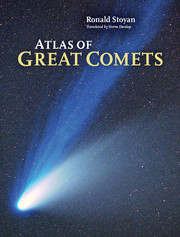Book contents
- Frontmatter
- Dedication
- Foreword
- Contents
- Using this book
- Introduction
- Cometary beliefs and fears
- Comets in art
- Comets in literature and poetry
- Comets in science
- Comet science today
- Great comets in antiquity
- Great comets in the Middle Ages
- Great Comets
- Appendix
- Glossary
- References
- Index
- Figure credits
Comets in science
from Introduction
Published online by Cambridge University Press: 18 December 2014
- Frontmatter
- Dedication
- Foreword
- Contents
- Using this book
- Introduction
- Cometary beliefs and fears
- Comets in art
- Comets in literature and poetry
- Comets in science
- Comet science today
- Great comets in antiquity
- Great comets in the Middle Ages
- Great Comets
- Appendix
- Glossary
- References
- Index
- Figure credits
Summary
Fifteenth and sixteenth centuries
For centuries the nature of comets was not a matter for consideration. Astrological theory was too strongly entrenched. It was only at the beginning of modern times that the fundamental question came to be posed: “Are comets meteorological or astronomical phenomena?” “Are they sublunar, being situated under the Moon, or are they supralunar, lying beyond it?”
These questions should have been answered by the determination of the distance of comets. The principle of distance determination rests on parallax, that is, on the apparent spatial shift in the positions of comets in front of a more distant background (the starry sky), based on viewing the comet from different angles. If comets were closer than the Moon, as Aristotelian doctrine held, then when comets were viewed from two different locations they should appear at different positions on the sky. Similarly, parallax should have been detected with observations from a single, fixed position over a period of some hours, if the comet were closer to the observer than the whole firmament, which was rotating around the Earth.
Before the discovery of the telescope in 1610, people tried to determine the positions of comets with the naked eye. In the Middle Ages, the instruments available were the torquetum and the cross-staff (or Jacob's staff). In early modern times, quadrants were also used, and the larger they were, the more accurate their determinations of positions. Astrolabes and armillary spheres were also employed.
The Italian geographer Paolo Toscanelli (1397–1482), famous for his (inaccurate) chart of the Atlantic Ocean that led Columbus to believe that a shorter route to India lay to the west, was one of the first people to determine the positions of comets. He followed six comets between 1433 and 1472 and recorded their motions across the sky. His notes were not rediscovered until the nineteenth century.
Information
- Type
- Chapter
- Information
- Atlas of Great Comets , pp. 27 - 36Publisher: Cambridge University PressPrint publication year: 2015
